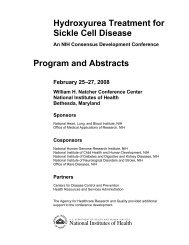5. Green PH, Fleischauer AT, Bhagat G, Goyal R, Jabri B, Neugut AI. Risk of malignancy inpatients with celiac disease. Am J Med. 2003;115:191–195.6. Holmes GKT, Prior P, Lane MR, Pope D, Allan RN. Malignancy in coeliac disease—effectof a gluten-free diet. Gut. 1989;30:333–338.7. Catassi C, Fabiani E, Corrao G, et al. Risk of non-Hodgkin lymphoma in celiac disease.JAMA. 2002;287:1413–1419.8. Hadjivassiliou M, Grunewald RA, Chattopadhyay AK, et al. Clinical, radiological,neuropscyhological, and neuropathological characteristics of gluten ataxia. Lancet.1998;352:1582–1585.9. Cellier C, Flobert C, Cormier C, Roux C, Schmitz J. Severe osteopenia in symptom-freeadults with a childhood diagnosis of coeliac disease. Lancet. 2000;355:806.10. Mustalahti K, Collin P, Sievänen H, Salmi J, Mäki M. Osteopenia in patients with clinicallysilent coeliac disease warrants screening. Lancet. 1999;354:744–745.11. Ventura A, Magazu G, Gerarduzzi T, Greco L. Coeliac disease and the risk of autoimmunedisorders. Gut. 2002;51:897–898.12. Sategna Guidetti C, Solerio E, Scaglione N, Aimo G, Mengozzi G. Duration of glutenexposure in adult coeliac disease does not correlate with the risk of autoimmune disorders.Gut. 2001;49:502–505.13. Collin P, Kaukinen K, Välimäki M, Salmi J. Endocrinological disorders and celiac disease.Endocrine Reviews. 2002;23:464–483.14. Volta U, De Franceschi L, Lari F, Molinaro N, Zoli M, Bianchi FB. Coeliac disease hiddenby cryptogenic hypertransaminasemia. Lancet. 1998;352:26–29.15. Kaukinen K, Halme L, Collin P, et al. <strong>Celiac</strong> disease in patients with severe liver diseases:gluten-free diet may reverse hepatic failure. Gastroenterology. 2002;122:881–888.85
Consequences of Testing for <strong>Celiac</strong> <strong>Disease</strong> Ann Cranney, M.D., M.Sc.ContextThe prevalence of silent cases of celiac disease (CD) may be eight times that ofclassically symptomatic CD, and it is important to determine if the consequences of testing andthe response to treatment differs by mode of diagnosis, and clinical presentation.ObjectiveTo conduct a systematic review of the expected consequences of testing for CD in thefollowing populations: (a) patients with symptoms suggestive of CD, (b) asymptomatic at-riskpopulations, and (c) the general population.Data SourcesA comprehensive literature search was conducted by the <strong>National</strong> Library of Medicinein collaboration with the University of Ottawa Evidence-Based Practice Center (UO-EPC). Thesearches were run in MEDLINE (1966–Oct 2003), EMBASE (1974–Dec 2003), CAB(1972–Dec 2003), PsycINFO (1840–2003), AGRICOLA (1970–2003), and SociologicalAbstracts (1963–2003).Study Selection and Data ExtractionThis review was conducted using accepted systematic review methodology. Twoindependent reviewers selected the articles using three levels of screening. The strategy includedarticles that dealt with the consequences of testing for CD. We did not include articles that dealtwith consequences addressed in celiac objectives one and two (e.g., cases diagnosed,false-positive results, invasive procedures [biopsies], and followup testing). Full data extractionwas conducted on all articles that met the level 3 screening requirements by one reviewer andthen verified by a second reviewer. The quality of the included studies was assessed. Outcomesincluded: (1) nutritional parameters (body composition and anthropometrics), anemia, anddiabetic control; (2) compliance with a gluten-free diet (GFD); (3) costs; and (4) other clinicalendpoints ( [a] osteoporosis and [b] mortality).Data SynthesisThe studies identified dealt primarily with small populations of symptomatic individualsand not all studies reported clinical presentation in detail. The number of studies evaluatingoutcomes in asymptomatic, screen-detected patients was small, and it was difficult to determineif outcomes differed by population and clinical presentation. The majority of studies evaluating87
- Page 1 and 2:
NIH Consensus Development Conferenc
- Page 3 and 4:
III. What Are the Manifestations an
- Page 5 and 6:
• What is the management of celia
- Page 7 and 8:
Monday, June 28, 2004 (continued)I.
- Page 9 and 10:
Monday, June 28, 2004 (continued)II
- Page 11 and 12:
Wednesday, June 30, 2004 (continued
- Page 13 and 14:
Lisa H. RichardsonConsumer Represen
- Page 15 and 16:
Ciaran P. Kelly, M.D.Director, Celi
- Page 17 and 18:
Van S. Hubbard, M.D., Ph.D.Director
- Page 19 and 20:
AbstractsThe following are abstract
- Page 21 and 22:
susceptibility (e.g., DR17 homozygo
- Page 23 and 24:
The Pathology of Celiac DiseaseDavi
- Page 25 and 26: In this regard, the transport pathw
- Page 27 and 28: for the IgG-based test, while speci
- Page 29 and 30: 15. de Lecea A, Ribes-Koninckx C, P
- Page 31 and 32: Clinical Algorithm in Celiac Diseas
- Page 33 and 34: Considera diagnosisof celiac diseas
- Page 35 and 36: There are populations at particular
- Page 37 and 38: Serological Testing for Celiac Dise
- Page 39 and 40: Estimates of the sensitivity of the
- Page 41 and 42: the risk and severity of CD may als
- Page 43 and 44: What Are the Prevalence and Inciden
- Page 45 and 46: ascribed to excess menstrual loss.
- Page 47 and 48: ReferencesFamily History of Celiac
- Page 49 and 50: Carroccio A, Iannitto E, Cavataio F
- Page 51 and 52: identified by surveys or through so
- Page 53 and 54: Clinical Presentation of Celiac Dis
- Page 55 and 56: een widely reported. The question r
- Page 57 and 58: The Many Faces of Celiac Disease: C
- Page 59 and 60: References1. Green PH, Jabri B. Coe
- Page 61 and 62: Association of Celiac Disease and G
- Page 63 and 64: Does the Gluten-Free Diet Protect F
- Page 65 and 66: Skin Manifestations of Celiac Disea
- Page 67 and 68: allow a better understanding of the
- Page 69 and 70: 4. Henriksson KG, Hallert C, Walan
- Page 71 and 72: characterized, clinically-identifie
- Page 73 and 74: 10. Hoffenberg EJ, Emery LM, Barrig
- Page 75: ataxia, epilepsy with posterior cer
- Page 79 and 80: Osteoporosis/FracturesThere were 11
- Page 81 and 82: Dietary Guidelines for Celiac Disea
- Page 85 and 86: 21. Thompson T. Thiamin, riboflavin
- Page 88 and 89: In order to effectively counsel ind
- Page 90 and 91: 9. Hallert C, Granno C, Hulten S, M
- Page 92 and 93: adhered to the GFD after more than
- Page 94 and 95: Patient education, close supervisio
- Page 96: 26. Mustalahti K, Lohiniemi S, Laip







